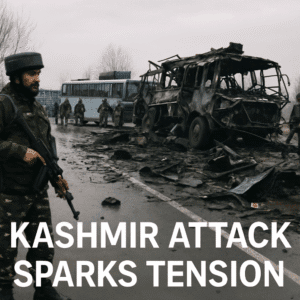Kashmir Attack Sparks Tensions: 5 Explosive Consequences That Could Ignite a Global Crisis
A deadly assault on tourists in Indian-administered Kashmir, killing 26, has reignited hostilities between nuclear rivals India and Pakistan. India accused Pakistan of backing the attack—a claim Islamabad denies—triggering tit-for-tat expulsions of diplomats, border closures, and suspension of a critical water-sharing treaty. Cross-border shelling and military drills amplify fears of escalation, with Pakistan’s army vowing a “swift response” to any aggression. U.S. Secretary of State Marco Rubio and Qatar’s Emir urged de-escalation, while India’s leadership pledged to pursue justice. The crisis underscores Kashmir’s volatile status, a decades-old flashpoint dividing the rivals. With both nations on high alert, international diplomacy faces a critical test to prevent a conflict with catastrophic regional consequences.

Kashmir Attack Sparks Tensions: 5 Explosive Consequences That Could Ignite a Global Crisis
The disputed Himalayan region of Kashmir has once again become the epicenter of a dangerous showdown between nuclear-armed neighbors India and Pakistan, following a deadly attack on tourists that has pushed both nations to the brink. As international mediators scramble to prevent escalation, here’s an analysis of the crisis, its roots, and what lies ahead.
The Spark: A Brutal Attack Ignites Old Wounds
On April 25, 2025, militants targeted a group of tourists in Pahalgam, a scenic town in Indian-administered Kashmir, killing 26 people—predominantly Hindu pilgrims. India swiftly accused Pakistan of backing the attack, a claim Islamabad denies. This incident mirrors past tragedies that have fueled cycles of retaliation, such as the 2019 Pulwama attack, which nearly triggered a war.
India’s response has been uncompromising: expelling Pakistani diplomats, suspending a critical water-sharing treaty (the Indus Waters Treaty), and closing airspace and borders. Pakistan retaliated with similar measures, while its military warned of a “swift, resolute” counterstrike to any Indian aggression.
Why Kashmir? The Perpetual Flashpoint
Kashmir’s history is etched with violence. Partitioned in 1947, both nations claim it in full and have fought three wars over it. The region remains heavily militarized, with sporadic skirmishes along the Line of Control (LoC)—a de facto border. For India, Kashmir symbolizes territorial integrity; for Pakistan, it’s a matter of ideological identity.
The attack on tourists—a rare target—suggests militants aim to destabilize India’s efforts to normalize Kashmir’s status after its 2019 autonomy revocation. By striking pilgrims, perpetrators sought to reignite religious polarization and undermine tourism, a key economic lifeline for the region.
Diplomatic Frenzy: U.S. and Qatar Step In
U.S. Secretary of State Marco Rubio’s calls to Indian and Pakistani leaders underscore Washington’s strategic stake in preventing a South Asian conflict. Rubio balanced condolences to India with appeals for restraint, reaffirming counterterrorism collaboration—a nod to India’s global influence. Meanwhile, Qatar’s Emir offered mediation, reflecting Gulf states’ growing role in regional diplomacy.
Pakistan’s Prime Minister Shehbaz Sharif leveraged the calls to demand an international probe, signaling Islamabad’s attempt to counter India’s narrative. Yet, trust remains absent: Pakistan alleges India plans imminent strikes, while India insists on holding Islamabad accountable.
Military Posturing: A Dangerous Game
Both armies have staged provocative drills. Pakistan’s General Asim Munir oversaw exercises simulating “near-battlefield conditions,” while India’s Defense Minister Rajnath Singh received assurances of U.S. support for self-defense. Nightly cross-border shelling—reported but unverified—adds to the volatility.
Experts warn that heightened alertness increases miscalculation risks. “Even accidental cross-border fire could spiral,” says security analyst Ayesha Siddiqa. “With nuclear doctrines in play, the stakes are existential.”
The Human Cost: Civilians in the Crossfire
Beyond geopolitics, the crisis devastates daily life. Thousands of diplomats and citizens have been expelled, families torn apart. Kashmir’s tourism sector—still recovering from past unrest—faces collapse as resorts shutter. Farmers on both sides fear water treaty suspensions could ignite resource wars, compounding economic strife.
Historical Echoes and Pathways Forward
India and Pakistan have navigated similar crises before, notably after the 2001 Parliament attack and 2008 Mumbai siege. Back-channel talks and third-party mediation often defused tensions, but current political climates differ. Indian Prime Minister Narendra Modi, eyeing a legacy of strength, faces domestic pressure to act decisively. Conversely, Sharif’s fragile coalition cannot afford perceived weakness.
Possible Scenarios:
- De-escalation: International pressure and behind-the-scenes dialogue cool tempers, as seen after 2019.
- Limited Conflict: Surgical strikes or cyberwarfare, avoiding full-scale war but prolonging instability.
- Unintended Escalation: A minor skirmish triggers broader conflict, with catastrophic humanitarian consequences.
Conclusion: A Test for Global Diplomacy
The Kashmir crisis is more than a regional dispute—it’s a litmus test for multilateral diplomacy. As U.S. and Qatari efforts unfold, the world watches whether lessons from past near-misses will prevail. For now, the region holds its breath, hoping rationality overcomes rhetoric.
The attack’s timing—amid global shifts toward multipolarity—highlights how regional conflicts can draw in emerging mediators like Qatar, reshaping traditional power dynamics. Yet, without addressing Kashmir’s core political grievances, cycles of violence will persist.
You must be logged in to post a comment.